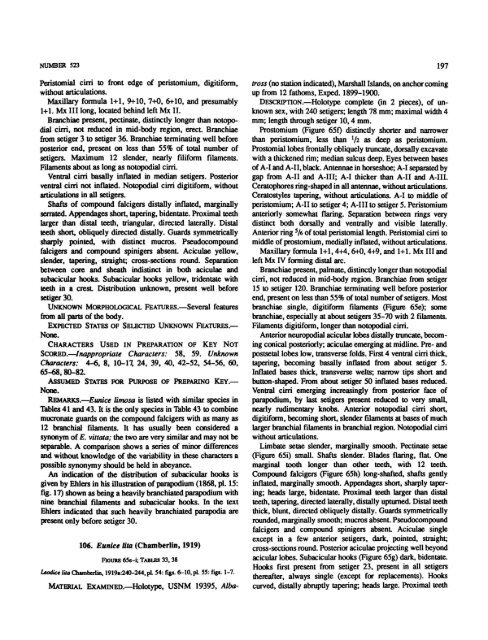A Review of the Genus Eunice - Smithsonian Institution Libraries
A Review of the Genus Eunice - Smithsonian Institution Libraries
A Review of the Genus Eunice - Smithsonian Institution Libraries
You also want an ePaper? Increase the reach of your titles
YUMPU automatically turns print PDFs into web optimized ePapers that Google loves.
NUMBER 523 197<br />
Peristomial cirri to front edge <strong>of</strong> peristomium, digitiform,<br />
without articulations.<br />
Maxillary formula 1+1, 9+10, 7+0, 6+10, and presumably<br />
1+1. Mx III long, located behind left Mx II.<br />
Branchiae present, pectinate, distinctly longer than notopodial<br />
cirri, not reduced in mid-body region, erect. Branchiae<br />
from setiger 3 to setiger 36. Branchiae terminating well before<br />
posterior end, present on less than 55% <strong>of</strong> total number <strong>of</strong><br />
setigers. Maximum 12 slender, nearly filiform filaments.<br />
Filaments about as long as notopodial cirri.<br />
Ventral cirri basally inflated in median setigers. Posterior<br />
ventral cirri not inflated. Notopodial cirri digitiform, without<br />
articulations in all setigers.<br />
Shafts <strong>of</strong> compound falcigers distally inflated, marginally<br />
serrated. Appendages short, tapering, bidentate. Proximal teeth<br />
larger than distal teeth, triangular, directed laterally. Distal<br />
teeth short, obliquely directed distally. Guards symmetrically<br />
sharply pointed, with distinct mucros. Pseudocompound<br />
falcigers and compound spinigers absent. Aciculae yellow,<br />
slender, tapering, straight; cross-sections round. Separation<br />
between core and sheath indistinct in both aciculae and<br />
subacicular hooks. Subacicular hooks yellow, tridentate with<br />
teeth in a crest Distribution unknown, present well before<br />
setiger 30.<br />
UNKNOWN MORPHOLOGICAL FEATURES.—Several features<br />
from all parts <strong>of</strong> <strong>the</strong> body.<br />
EXPECTED STATES OF SELECTED UNKNOWN FEATURES.—<br />
None.<br />
CHARACTERS USED IN PREPARATION OF KEY NOT<br />
SCORED.—Inappropriate Characters: 58, 59. Unknown<br />
Characters: 4-6, 8, 10-17, 24, 39, 40, 42-52, 54-56, 60,<br />
65-68,80-81<br />
ASSUMED STATES FOR PURPOSE OF PREPARING KEY.—<br />
None.<br />
REMARKS.—<strong>Eunice</strong> limosa is listed with similar species in<br />
Tables 41 and 43. It is <strong>the</strong> only species in Table 43 to combine<br />
mucronate guards on <strong>the</strong> compound falcigers with as many as<br />
12 branchial filaments. It has usually been considered a<br />
synonym <strong>of</strong> E. vittata; <strong>the</strong> two are very similar and may not be<br />
separable. A comparison shows a series <strong>of</strong> minor differences<br />
and without knowledge <strong>of</strong> <strong>the</strong> variability in <strong>the</strong>se characters a<br />
possible synonymy should be held in abeyance.<br />
An indication <strong>of</strong> <strong>the</strong> distribution <strong>of</strong> subacicular hooks is<br />
given by Enters in his illustration <strong>of</strong> parapodium (1868, pi. 15:<br />
fig. 17) shown as being a heavily branchiated parapodium with<br />
nine branchial filaments and subacicular hooks. In <strong>the</strong> text<br />
Ehlers indicated that such heavily branchiated parapodia are<br />
present only before setiger 30.<br />
106. <strong>Eunice</strong> lita (Chamberlin, 1919)<br />
FIGURE 65c-i; TABLES 33,38<br />
Leodice lita Chwnberlin, 1919a:240-244, pi. 54: figs. 6-10, pi. 55: figi. 1-7.<br />
MATERIAL EXAMINED.—Holotype, USNM 19395, Albatross<br />
(no station indicated), Marshall Islands, on anchor coming<br />
up from 12 fathoms, Exped. 1899-1900.<br />
DESCRIPTION.—Holotype complete (in 2 pieces), <strong>of</strong> unknown<br />
sex, with 240 setigers; length 78 mm; maximal width 4<br />
mm; length through setiger 10,4 mm.<br />
Prostomium (Figure 650 distinctly shorter and narrower<br />
than peristomium, less than l /i as deep as peristomium.<br />
Prostomial lobes frontally obliquely truncate, dorsally excavate<br />
with a thickened rim; median sulcus deep. Eyes between bases<br />
<strong>of</strong> A-I and A-II, black. Antennae in horseshoe; A-I separated by<br />
gap from A-II and A-III; A-I thicker than A-II and A-III.<br />
Ceratophores ring-shaped in all antennae, without articulations.<br />
Ceratostyles tapering, without articulations. A-I to middle <strong>of</strong><br />
peristomium; A-II to setiger 4; A-III to setiger 5. Peristomium<br />
anteriorly somewhat flaring. Separation between rings very<br />
distinct both dorsally and ventrally and visible laterally.<br />
Anterior ring 5 /6 <strong>of</strong> total peristomial length. Peristomial cirri to<br />
middle <strong>of</strong> prostomium, medially inflated, without articulations.<br />
Maxillary formula 1+1,4+4,6+0,4+9, and 1+1. Mx III and<br />
left Mx IV forming distal arc.<br />
Branchiae present, palmate, distinctly longer than notopodial<br />
cirri, not reduced in mid-body region. Branchiae from setiger<br />
15 to setiger 120. Branchiae terminating well before posterior<br />
end, present on less than 55% <strong>of</strong> total number <strong>of</strong> setigers. Most<br />
branchiae single, digitiform filaments (Figure 65e); some<br />
branchiae, especially at about setigers 35-70 with 2 filaments.<br />
Filaments digitiform, longer than notopodial cirri.<br />
Anterior neuropodial acicular lobes distally truncate, becoming<br />
conical posteriorly; aciculae emerging at midline. Pre- and<br />
postsetal lobes low, transverse folds. First 4 ventral cirri thick,<br />
tapering, becoming basally inflated from about setiger 5.<br />
Inflated bases thick, transverse welts; narrow tips short and<br />
button-shaped. From about setiger 50 inflated bases reduced.<br />
Ventral cirri emerging increasingly from posterior face <strong>of</strong><br />
parapodium, by last setigers present reduced to very small,<br />
nearly rudimentary knobs. Anterior notopodial cirri short,<br />
digitiform, becoming short, slender filaments at bases <strong>of</strong> much<br />
larger branchial filaments in branchial region. Notopodial cirri<br />
without articulations.<br />
Limbate setae slender, marginally smooth. Pectinate setae<br />
(Figure 65i) small. Shafts slender. Blades flaring, flat. One<br />
marginal tooth longer than o<strong>the</strong>r teeth, with 12 teeth.<br />
Compound falcigers (Figure 65h) long-shafted, shafts gently<br />
inflated, marginally smooth. Appendages short, sharply tapering;<br />
heads large, bidentate. Proximal teeth larger than distal<br />
teeth, tapering, directed laterally, distally upturned. Distal teeth<br />
thick, blunt, directed obliquely distally. Guards symmetrically<br />
rounded, marginally smooth; mucros absent. Pseudocompound<br />
falcigers and compound spinigers absent. Aciculae single<br />
except in a few anterior setigers, dark, pointed, straight;<br />
cross-sections round. Posterior aciculae projecting well beyond<br />
acicular lobes. Subacicular hooks (Figure 65g) dark, bidentate.<br />
Hooks first present from setiger 23, present in all setigers<br />
<strong>the</strong>reafter, always single (except for replacements). Hooks<br />
curved, distally abruptly tapering; heads large. Proximal teeth
















